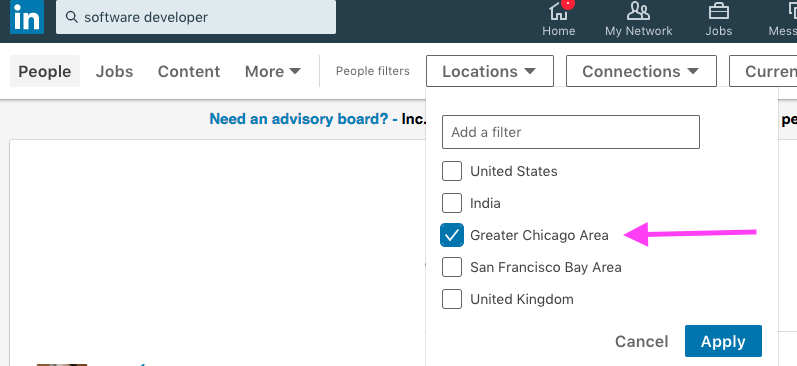In the previous post, we explained that micronetworking – or having one-on-one networking meetings with people – is the key job hack for tapping the hidden job market. But how do you go about finding people to meet with, and actually get them to agree to meet with you?
LinkedIn is the most indispensable tool for micronetworking, so if you do not yet have a LinkedIn account, I highly recommend that you get one now. In fact, LinkedIn is a tool that we’ll keep coming back to in all sorts of job hacks – so please, do sign up with them today. (In future posts, I’ll explain how to optimize your LinkedIn profile page so it can give you the best results, but for now, just make sure to have your basic details listed.)
With LinkedIn and email, you can (almost) guarantee success in landing job networking meetings, and the process is painless and simple:
First, use LinkedIn to search for local people in your desired industry (i.e. the industry you’d like to work in). To do so, enter a job title in the search bar up on top. As an example, let’s say I’m looking for a position as a software developer. One job title I might search for is “software developer”:
![]()
After hitting “Enter,” one should use the “Locations” filter to narrow down the search results to people in your target geographic location (the city you’d like to work in). Let’s say we want to work in Chicago:

Next, LinkedIn will provide you with a list of people that you can connect with: (I’ve blacked out people’s names to respect their privacy.)

You’ll notice that many people have a “Connect” button next to them. (Not everyone will, but there should plenty of people who do.) Click the “Connect” button on a whole bunch of people. How many, exactly? Well, that depends on how many people you want to meet with – we’ll delve into those numbers later.
Now, not everyone will accept your invite to become a LinkedIn connection, but that’s okay, because there are plenty of people who will. It might take some people a few days – or even longer – to accept your connection request. How many people will accept your request? In cases where you don’t know them, and they don’t know you, and you don’t send a personal note along with the request, 15% to 40% will accept your request. We’ll explore how to increase those percentages in future posts, but 15% to 40% is good enough for now – it’s all you’ll need to land meetings.
Once someone does accept your connection request, congrats! They are now, in LinkedIn parlance, your 1st-degree connection. And that means that you now have access to their email address. How?
Simply go to your 1st-degree connection’s LinkedIn profile, and click on the section “Show more” link inside the section called “Contact and Personal Info”. As of this writing, this section is to the top-right of the page:

Once you click that link, the contact’s email address will be revealed. (In 1% of cases, their email will not be revealed, as the contact may have blocked it in their privacy settings. But 99% is a good-enough rate for us!)
Next, send the contact an email. I don’t recommend sending a message through LinkedIn, as emails are much more effective. Everyone looks at their emails, while many people ignore their LinkedIn messages.
I hesitate to give an exact email template – because many people will just copy and paste it, thereby ruining its effectiveness, but here are the rough guidelines for the email:
Almost any subject will do, as long as it doesn’t sound like it comes from a corporation. Keep it personal and human.
In the body of your email, you’ll put two paragraphs. That’s it. People don’t like to read long emails.
In the first paragraph, you’ll thank the contact for connecting on LinkedIn, and then give them one or two sentences about your background.
In the second paragraph, you’ll ask them if they can meet for just 20 minutes for coffee/tea (or a phone call if you or they can’t meet in person), as you’d like to ask them for their advice regarding the industry (that you’re looking to get a job in).
When you’re not used to doing this, it may seem awkward at first to ask random people to meet you for coffee. But do you know how many people will take you up on your invite?
10%.
In my experience working with hundreds of people, this magic number of 10% seems to be rock solid. That is, if you ask ten random people do meet you for a micronetworking coffee meeting, one will actually agree.
Go ahead – try it for yourself! Once you start doing this, you’ll find that it becomes much easier and natural pretty quickly.
That’s really it. Don’t worry about what you’ll actually do in the coffee meeting – we’ll cover that in the next post.

